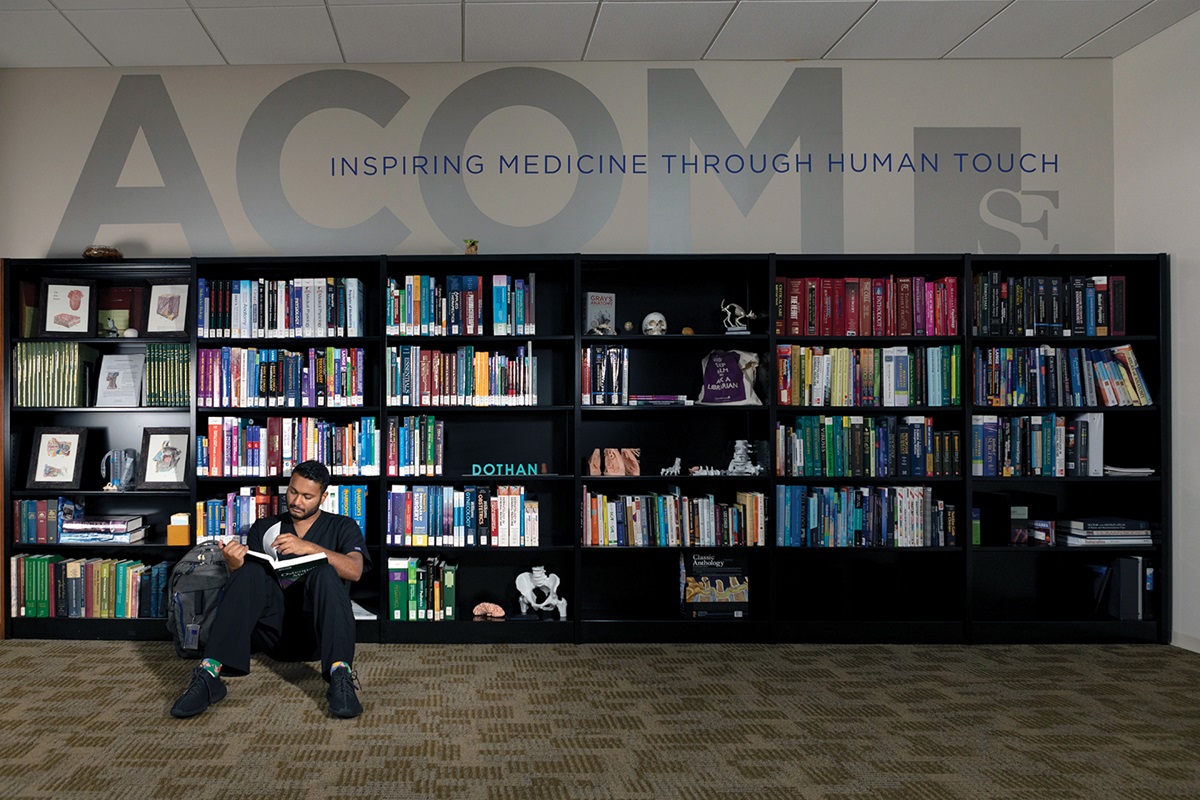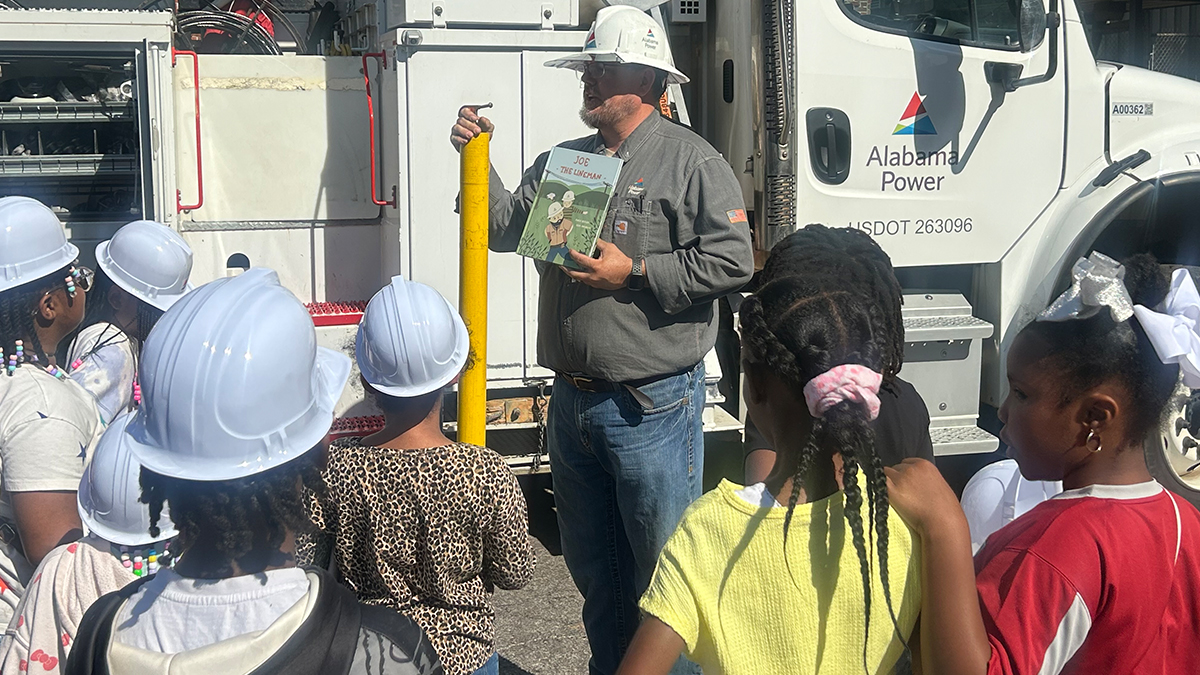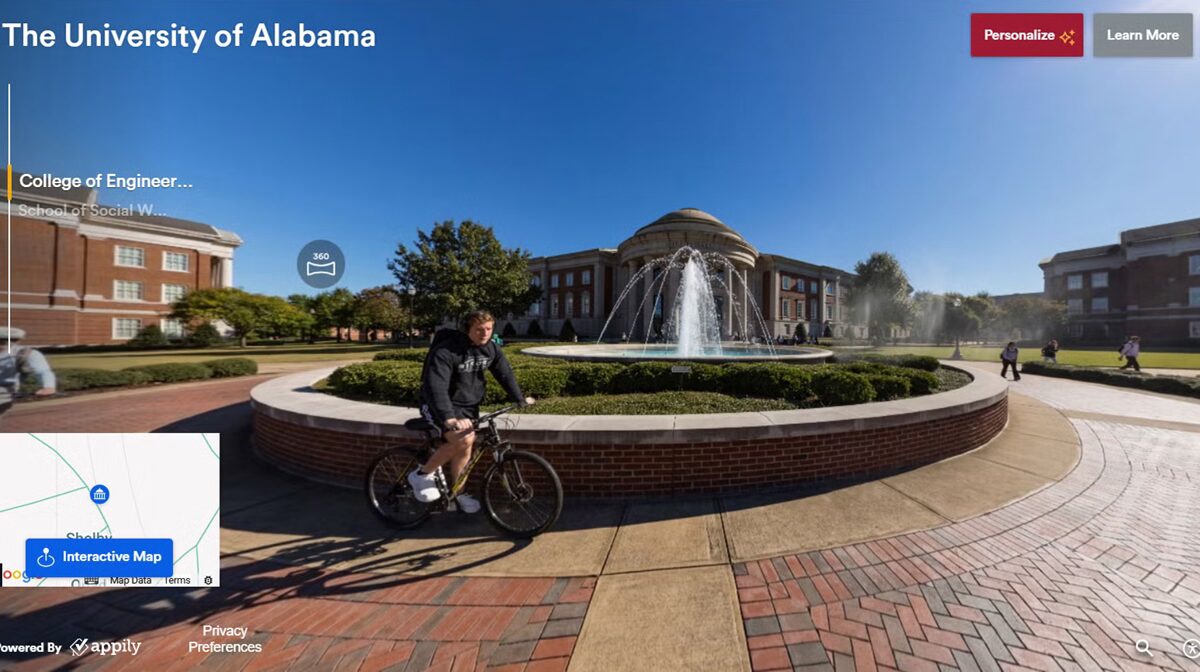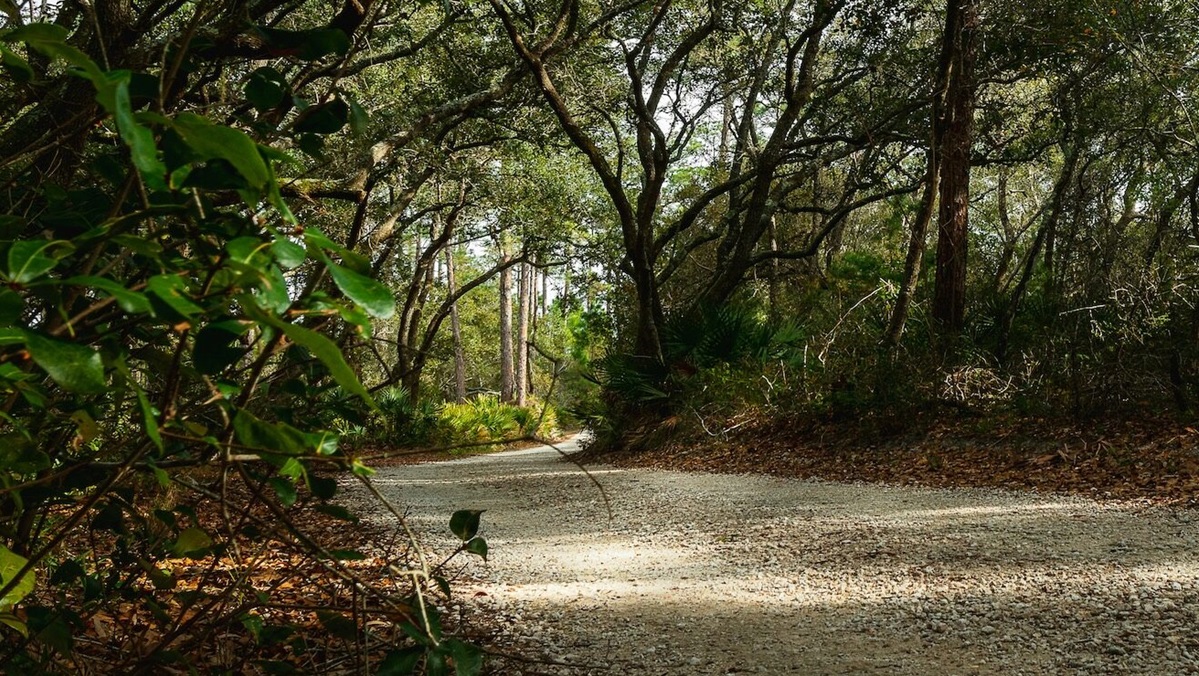Growing Alabama College of Osteopathic Medicine in Dothan trains doctors to treat body, mind and spirit

Richard R. Thacker, D.O., associate dean of Clinical Sciences at the Alabama College of Osteopathic Medicine, talks with students between classes. (contributed)
Aaron Tillman enjoyed his career as a physical therapist, helping people get back on their feet after hip and knee surgery and working with athletes to return to the playing field after an injury. He’d never considered another career, but after working near two doctors of osteopathic medicine, he realized their field of medicine was much like what he was practicing as a therapist. He was intrigued.
“It really opened my eyes,” says the 33-year-old. While medical doctors (MDs) practice allopathic medicine, which focuses on diagnosing and treating specific diseases, doctors of osteopathic medicine (DOs) treat patients holistically, treating the body as a unit of body, mind and spirit, as well as using manipulation of the musculoskeletal system to aid the body in healing itself.
After connecting with a graduate of the Alabama College of Osteopathic Medicine (ACOM) in Dothan, it wasn’t long before Tillman decided to change careers and moved from Jacksonville, Florida, to enroll in the school. Today, he is on track to graduate in 2026, has served as Student Government Association president and is one of the college’s biggest cheerleaders.
“When we’re doing our clinical rotation, the emphasis with patients is, ‘How is this issue affecting your life?’” he says. “You’re a whole person. If your body is affecting your mind and spirit, then being able to address the patient as a person rather than just their diagnosis affects the whole body of care.”
This type of approach to medical education has attracted more than 1,200 students who’ve graduated from the college since it was founded as the academic division of Southeast Health in 2013. The school graduated its first class in 2017.
“To begin with, we were accredited to have a class of 150, and it’s now grown to 210,” says Carmen Lewis, Ph.D., vice president of institutional effectiveness. “We accept that many each year. That’s the largest medical school by enrollment in Alabama.”
College officials are particularly proud that their graduates have a top placement rate in residency programs, placing 99% in 21 medical specialties, Lewis says. “We focus particularly on primary care areas — internal medicine, pediatrics, family medicine and obstetrics and gynecology.”

A medical student takes advantage of the ACOM Library, one of many study areas on campus. (contributed)
ACOM was created in 2013 to address Alabama’s physician shortage and increase access to medical services, particularly primary care. To date, 77 ACOM graduates are practicing in Alabama, with 24 coming back to practice in the Wiregrass area. School officials want to increase those numbers.
“The intent is to get them back to this geographic area to provide healthcare services to the community,” says Rick Sutton, a healthcare veteran who is president of ACOM and CEO of Southeast Health. Studies show that 75% of residents will practice within 75 miles of where they practice residency. “So you want to create more residencies; you want them to stay there.”
James Jones, D.O., ACOM’s dean who worked as an emergency physician before joining the college, says the college has worked with eight hospitals in Alabama to create 12 programs in family medicine, internal medicine, psychiatry and other specialties. “In these hospitals we’ve created 138 new first-year residency slots that weren’t here before 2018,” he says. “This will hopefully do what Rick said and keep our trainees who are in the state to stay in the state and serve our communities.”
School officials also realize the importance of attracting and retaining quality faculty members.
“If you look across the country, there’s a worker shortage in nearly everything,” Sutton says. “You’ve got to concentrate on retaining people, and we do that.” Sutton points to a recent Gallup survey ranking the college in the 95th percentile nationally for employee engagement. Forbes also recently recognized the Southeast Health system, of which ACOM is a part, as the best midsize employer in the state. “That speaks to the culture we’re trying to build with our staff,” Lewis says. “People want to be a part of that team.”
Lewis points out that the college operates on three pillars: teaching, research and service. “Especially service to the community,” she says. “We love this community. It embraces ACOM. It is so heart-warming. We are committed to giving back, as demonstrated by our students’ extensive community volunteering. During the 2023-24 academic year, our students completed 10,572 hours of volunteer work.”

The college’s 110,000-square-foot facility in Dothan is equipped with the latest technology in its classrooms, laboratories and auditoriums. (Lenore Vickrey / Alabama Living)
ACOM’s 32 student organizations offer many opportunities for students to give back, Tillman noted. Two rural Houston County clinics, one in Ashford and another in Taylor, are also extending the reach of the college in previously underserved areas.
To carry through osteopathic medicine’s focus on holistic health, ACOM offers a number of wellness-focused features, including a volleyball court, nature trails, meeting-free Wellness Wednesdays, a community garden to grow fruits and vegetables, and an outdoor pavilion/classroom with a teaching kitchen to showcase demonstrations of healthy food preparation.
“We believe we can impact future patients by teaching our students the importance of preparing nutritious meals, which ultimately leads to disease prevention,” Jones says.
The school also emphasizes the importance of caring with compassion and empathy, Jones adds. “For example, we have a required rotation for hospice,” which is not a typical rotation for doctors in training. “But we believe it’s important to create a kind, compassionate physician.”
The school also has a Willed Body Program. While many medical schools have come to rely on digital dissection models, ACOM uses cadaver dissection to teach anatomy and its relation to pathology and disease. “Our Willed Body Program is a way for people in this area to make a body donation to help our students,” says Jones. “Having the program is a large benefit to the community, and it costs nothing to the patient or the family.”

Students study in the ACOM Osteopathic Principles and Principle Lab. (contributed)
Students then pay tribute to the person who helped them in the lab at a “First Patient Memorial Service.” Families are invited to attend, and the names of the donors are displayed. “Our students are very appreciative of that, and it’s a great way we serve the community and the community serves us,” says Jones. “The students consider those anatomical donors their first patient.”
As a student who’s experienced the program, Tillman agrees. “It ups the sanctity of the whole anatomical process. I don’t think there’s a better way to learn the human body.”
Area residents are also involved in training students through the Standardized Patient Program, Lewis adds, in which local residents are trained to act like real patients in scenarios with students. “They come in, memorize a script, and students examine them and create a treatment plan.”
What’s next for ACOM in the next 10 years? “We want to continue doing what we’re doing and being successful, looking to grow the campus in ways that support our students,” Jones says.
“Our culture is very important to us,” Lewis says. “People come here, they see the building, that we’re blessed to have a medical center in our system. How many people get to say they’re teaching future physicians? It gets you excited and makes you want to come to work every day.”
This story originally appeared in Alabama Living magazine.





